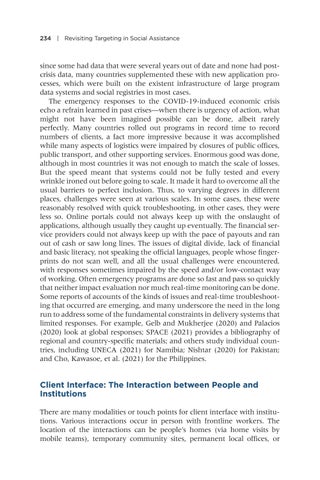234 | Revisiting Targeting in Social Assistance
since some had data that were several years out of date and none had postcrisis data, many countries supplemented these with new application processes, which were built on the existent infrastructure of large program data systems and social registries in most cases. The emergency responses to the COVID-19-induced economic crisis echo a refrain learned in past crises—when there is urgency of action, what might not have been imagined possible can be done, albeit rarely perfectly. Many countries rolled out programs in record time to record numbers of clients, a fact more impressive because it was accomplished while many aspects of logistics were impaired by closures of public offices, public transport, and other supporting services. Enormous good was done, although in most countries it was not enough to match the scale of losses. But the speed meant that systems could not be fully tested and every wrinkle ironed out before going to scale. It made it hard to overcome all the usual barriers to perfect inclusion. Thus, to varying degrees in different places, challenges were seen at various scales. In some cases, these were reasonably resolved with quick troubleshooting, in other cases, they were less so. Online portals could not always keep up with the onslaught of applications, although usually they caught up eventually. The financial service providers could not always keep up with the pace of payouts and ran out of cash or saw long lines. The issues of digital divide, lack of financial and basic literacy, not speaking the official languages, people whose fingerprints do not scan well, and all the usual challenges were encountered, with responses sometimes impaired by the speed and/or low-contact way of working. Often emergency programs are done so fast and pass so quickly that neither impact evaluation nor much real-time monitoring can be done. Some reports of accounts of the kinds of issues and real-time troubleshooting that occurred are emerging, and many underscore the need in the long run to address some of the fundamental constraints in delivery systems that limited responses. For example, Gelb and Mukherjee (2020) and Palacios (2020) look at global responses; SPACE (2021) provides a bibliography of regional and country-specific materials; and others study individual countries, including UNECA (2021) for Namibia; Nishtar (2020) for Pakistan; and Cho, Kawasoe, et al. (2021) for the Philippines.
Client Interface: The Interaction between People and Institutions There are many modalities or touch points for client interface with institutions. Various interactions occur in person with frontline workers. The location of the interactions can be people’s homes (via home visits by mobile teams), temporary community sites, permanent local offices, or


